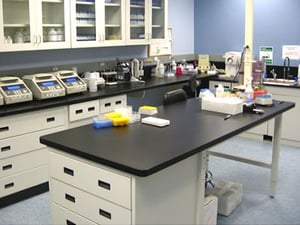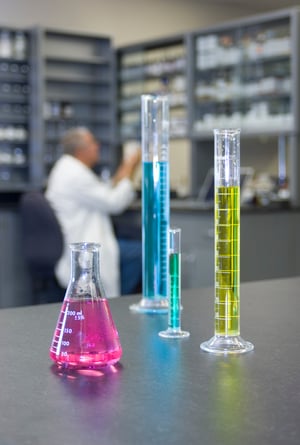The countertop you choose for your lab is a statement piece.
It plays a major role in what your lab accomplishes, setting the tone for your workspace in both appearance and functionality.
When it comes to having the opportunity to customize this work surface, solid surface countertops are among the materials that offer some of the most options.
Here are four ways to bring out the detail of your solid surface countertops through customization:
- Colors and patterns
- Finishes
- Uses
- Edging
Colors And Patterns
Solid surface countertops contain a non-porous, homogeneous material that consists of the same composition throughout. Solid surface is similar to plastic in that it is usually made from a resin and features a filler material. The end result is around 66% minerals and 33% binding resins.
throughout. Solid surface is similar to plastic in that it is usually made from a resin and features a filler material. The end result is around 66% minerals and 33% binding resins.
When solid surface countertops are constructed, the minerals and binding resins are mixed with a powdered filler (typically aluminum trihydrate) and pigments. These fillers and pigments offer a rich color palette of choices that allow you to customize the look of your space.
Whether it’s clean, sleek white or vibrant reds, warm golds or bold blues, the option to choose a color that matches your branding or provides a customized look to your lab is a benefit many enjoy.
Resin materials can vary from acrylic to polyester and plastic as well. The mineral portion often depends on what the client envisions for the countertop’s final look. Many choose to have the minerals mimic the appearance of granite, marble and natural stone for a high-end look.
Finishes
Manufacturers can add special finishes like gel coating, gloss, matte and textured appearances that offer subtle patterns.
While glossy finishes reflect a great amount of light and give rooms a shiny, sleek look, it’s important to note that they can be more difficult to maintain. For example, glossy finishes are more prone to showing scratches in the countertop.
Matte or semi-gloss finishes are easier to clean than high-gloss finishes. To remove brown stains, you can use cleaners made with oxalic acid. For stains from dyes, blood and other substances like vinegar, you can use a damp cloth and a small amount of mild abrasive cleaner.
However, with a high gloss finish, it is best to seek professional help from repair companies that will use sanders and low-speed polishers to create uniform finishes. A manufacturer or professional countertop repair company will then refinish and polish your countertop to return it to its high-gloss finish.
Uses
While solid surface material is widely known for its use in manufacturing countertops, it can be used to create other accompanying pieces as well.
other accompanying pieces as well.
Solid surface material is soft, more so than many other types of materials. Because of this, manufacturers can shape solid surfaces several ways under heat and pressure.
This feature allows manufacturers to create large pieces of countertop or to mold several pieces to fit perfectly together. Manufacturers can also mold solid surface material to create sinks, backsplashes and other fixtures found in manufacturing and laboratory spaces.
Don’t let the soft feature of a solid surface fool you, however. Among a solid surface counter’s many advantages, this material offers high impact resistance thanks to its homogeneous makeup. This makeup allows it to fare better against impacts than multi-layered countertops like laminate.
Other advantages include its easy maintenance (they don’t require extensive care for cleaning … just soap and water or a mild cleaner), and they are non-porous. This means moisture cannot seep through the surface, preventing bacteria, mildew and stains from forming.
This advantage makes it a great option for multiple environments and uses. Solid surface’s low porosity promotes a cleaner, more sanitary workspace. Offices and labs that require hygienic areas, like doctor’s offices and dental offices, can benefit from this.
Solid surface is also popular in the food service industry and in food labs since they offer protection against bacteria, mildew and stains.
Edging
Because solid surface material can be easily molded into different shapes and sizes, this affords manufacturers the opportunity to create a wide variety of edging options for customers. This is an important solid surface countertop detail to consider, since many opt for this material because of its customizable features.
While edging options vary by manufacturing, some of the most popular include:
- French cove
- Beveled
- Top and bottom beveled
- Bullnose
- Roundover
- Small and large ogee
When choosing edges, consider factors like the style of your lab space and budget, since a more detailed edge can come at a higher cost.
The best countertop manufacturers or suppliers will work with you to determine what types of customizations you can get on your budget. They will also be open with you about an anticipated timeline to receive your order and ensure any other needs for this important purchase are met.


